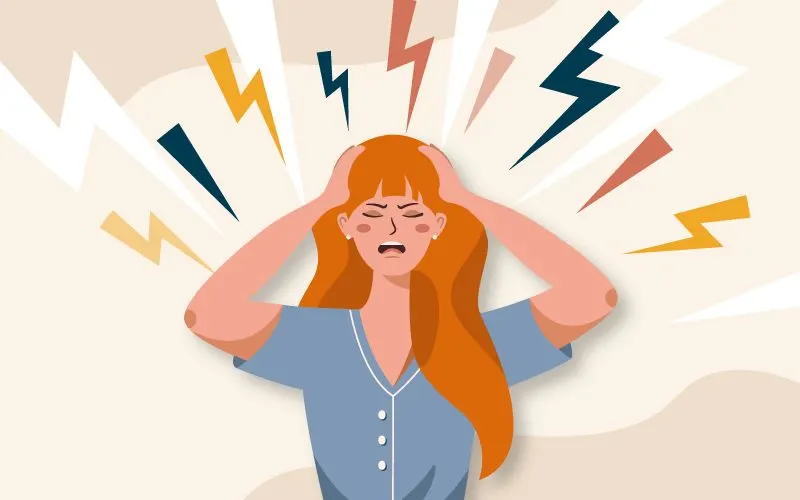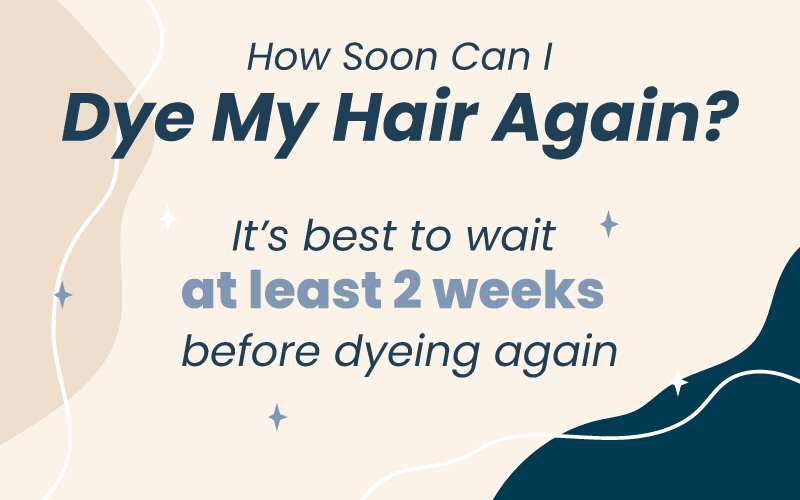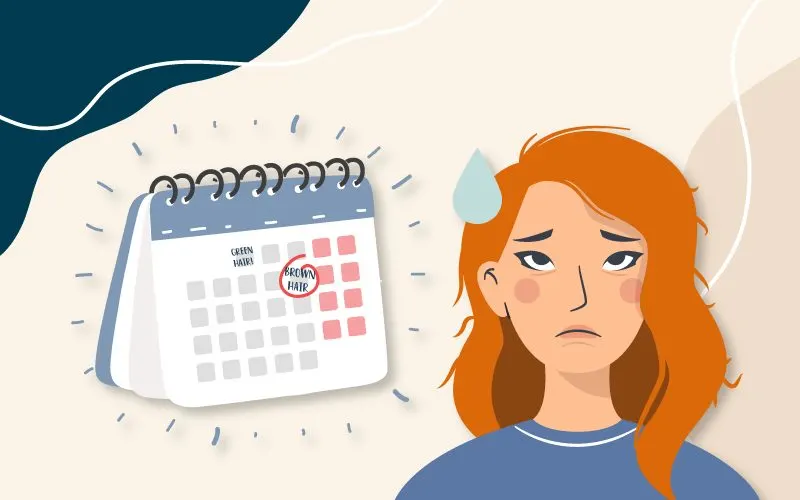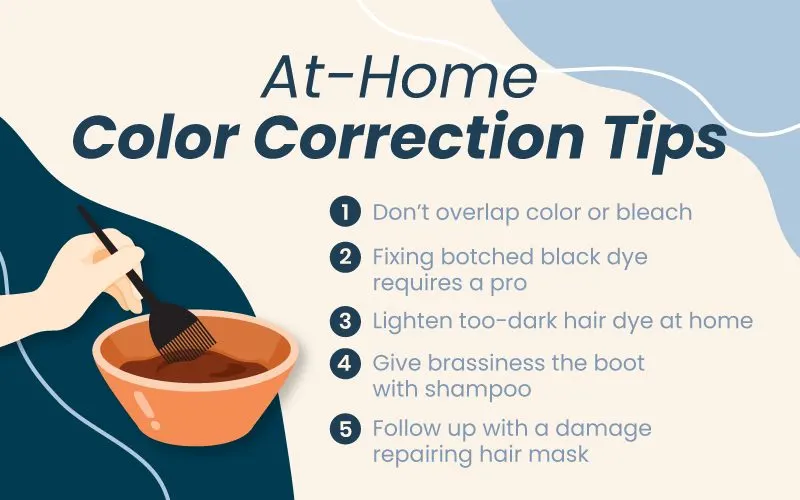Jump to:
Overestimated your hair coloring skills or got a little ballsy with the bleach? If your first reaction after botching a DIY dye job is “How soon can I dye my hair again to fix it?”, take comfort. You might not have to wait as long as you think. We’ll get you all sorted out with this guide to DIY color correction.
Uh Oh. Bad Dye Job? Don’t Panic

Did your DIY dye job go wrong? You’re definitely not alone. Doing your own hair color is notoriously difficult. Even experts have occasional “oops” incidents with hair dye.
Color correction is needed to fix a bad color, whether it’s spotty, brassy, showing lines, under-or over-processed, or the wrong color entirely.
But color correction isn’t easy, and it’s not without risks. You don’t want to cause irreparable damage by dying or bleaching your hair again too soon. So it’s important to know how long you should wait before trying to fix it.
Look below to see how soon you can dye your hair again to fix it, plus color correction tips for the most common DIY hair dye problems.
How Soon Can I Dye My Hair Again to Fix It?

When you can safely dye your hair again depends on a few factors. Everyone’s hair is different, and the type and color of dye you used (as well as the developer volume) will determine how soon you can re-dye your hair.
- Is your hair damaged? If your hair was already damaged before you dyed it, you shouldn’t attempt to re-dye your hair for at least 2 weeks, but preferably closer to 4 weeks. If your hair was healthy before but looks or feels damaged after coloring it, wait a minimum of 2 weeks before dying it again.
- What kind of hair dye did you use? Was your hair dye semi-permanent, demi-permanent, or permanent? Permanent hair dye causes more hair damage and shouldn’t be used again for at least 2 weeks.
- What developer volume did you use? The developer cream that comes with most box dyes is usually 20 volume (lifts or darkens hair 1-2 shades), but yours might’ve had 10 volume or 30-40 volume instead. If you used 10 or 20 volume developer, you will be able to dye your hair again sooner because they are less damaging to your hair.
Damaged hair – and it doesn’t matter how it was damaged – needs an extended break in between chemical processing sessions to recover. When you dye, chemically straighten, bleach, heat style, or even roughly comb your hair, you’re wearing the outermost layer away.
Damage can cause negative changes in the structure and appearance of your hair when it gets bad. You’ll notice that your hair has some of the following symptoms if it’s severely damaged:
- Frizzy
- Breaking off
- Falling out
- Dull or waxy
- Chronically dry
- Brittle and straw-like
- Oily or limp
Wait At Least 2 Weeks to Re-Dye

Trichologists (hair scientists) recommend waiting at least 2 weeks – but technically 15 days – before you re-dye your hair if it’s already damaged. This is especially true if you’ve used permanent hair color or a high-volume developer (30 or 40 volume).
After the 2 weeks is up, you can safely re-dye your hair with demi-permanent dye. If you need to use a semi-permanent or permanent dye, it’s a good idea to wait a little longer than 2 weeks since those dyes cause more damage to your hair. Aim for at least 4 weeks, or one month, to re-dye your hair in these cases.
What Happens If You Dye Your Hair Again Too Soon
If 2+ weeks seems like a long time to wait, you’re probably thinking about just going for it and re-dying your hair right away. Don’t do it! Sure, it’s not unheard of for someone to dye their hair twice in a single day, or to wait just a day or two before applying a new color.
But dying it again so soon is a terrible idea. If you dye your hair again too soon, the first thing you’ll notice is a sudden, noticeable increase in breakage. Your hair shaft may begin breaking off at any point – high up, near the roots, mid-way down, or at the ends.
As a result, you’ll start noticing tons of pesky flyaways where your hairs have broken off. You may also notice changes in the way your hair feels and looks. Healthy hair looks full and shiny and feels soft and manageable (easily combed/brushed).
Hair that has been dyed back-to-back will be seriously damaged, so you might notice it suddenly feels dry, brittle, and straw-like. Or the opposite could happen, resulting in oily, limp locks that have no volume. But will these effects really happen to you if you re-dye your hair too soon? Almost certainly yes.
Remember that hair dye is an extremely alkaline product, and that alone will cause some level of damage to hair strands. Add developer to the party, which helps lift the outermost cuticle layer to allow the dye molecules inside, and you’ve got a recipe for serious damage and breakage.
And if you used permanent hair color, which contains harsh ammonia or ethanolamine, the damage will be even more extensive. Fortunately, you can avoid damaging your hair this way by waiting the recommended amount of time before dying it again – at least 2 weeks.
At-Home Color Correction Tips

If you’re not convinced it’s time to go to the salon just yet, you can try correcting your color on your own at home. We have some helpful color correction tips so you can flawlessly fix your current color sitch.
Don’t Overlap Color or Bleach
If your color came out uneven, spotty, with lines/bands, or too far down from the roots, you’ll be going back over the missed areas with bleach or the same color dye to fix the issue.
But you should be very careful as you apply the dye or bleach. Make sure you don’t overlap any previously colored or bleached areas during your second go-round.
- If you overlap color, you’ll get the dreaded “halo effect” or color banding effect. It’s a band of overlapped color that looks darker than the rest.
- If you overlap bleach, you end up double-processing the overlapped area and it becomes severely damaged. That level of damage can cause the overlapped hair to weaken and break off, giving you an unwanted “chemical haircut.”
Fixing Botched Black Dye Requires a Pro
If you used black hair dye, just know upfront: It’s probably not going to budge with at-home color correction efforts. Black box dye typically must be stripped by a professional over 1-2 salon visits. Many people report that the best possible result of stripping black dye is getting the hair to a light yellow or orange so it can be recolored or lightened to a palatable shade.
If you’ve dyed your hair black and want to dye it again to fix it, leave it to a professional. There’s too much risk of over-processing your hair, resulting in weakness and noticeable breakage. A professional will be able to make the process as gentle on your hair as possible.
Lighten Too-Dark Hair Dye at Home
If you’re itching to re-dye your hair because it came out too dark, wait! You have options to lighten your hair dye without recoloring or bleaching, which will further damage your hair.
And since removing hair dye by chemically stripping it is just as damaging, it’s best to avoid right after dying your hair. Instead, you can use natural methods like baking soda and dandruff shampoo slurry or white vinegar hair mask to fade your color to something a little lighter.
You can also opt for a mix of vitamin C tablets and clarifying shampoo to lighten hair dye that’s too dark. Find out how to lighten your hair dye step-by-step in our complete guide: How to Lighten Dyed Hair.
Give Brassiness the Boot With Shampoo
If your color came out too warm or brassy, it can be tempting to re-dye your hair to cover it up. But since you’ll need to wait at least 2 weeks to dye it again, you’ll want an instant solution for brassiness. A toning shampoo might do the trick.
Purple shampoo targets unwanted yellow pigments that pop up in bleached blonde or gray/silver hair. Blue shampoo targets unwanted orange pigments that show up in brunette shades.
Determine which type of toning shampoo you need and use it 2-3 times a week to get rid of any brassiness. After 2 weeks, you may want to apply a cool-toned demi-permanent toner to neutralize those brassy pigments more long-term.
Follow Up With a Damage Repairing Hair Mask
Whether you decide to hold off on re-dying your hair, visit a salon for color correction, or go ahead and take the risk of dying it again too soon, your hair will have been damaged to some extent. The best thing you can do is reach for a hair mask for damaged hair.
A damage-repairing hair mask will contain keratin or other protein sources to rebuild the broken bonds in your hair due to dying or bleaching. These masks aren’t like deep conditioning or moisturizing masks, so don’t expect your hair to have that signature “slip” like it does with moisturizing treatments.
Instead, a mask for damage repair will go to work repairing the internal damage done to hair by chemical processing. Check out our guide (linked above) to see our top recommendations for damage-repairing hair masks.
So, Is It Too Soon to Dye My Hair Again?

Has it been at least 2 weeks since you used a permanent hair dye or bleach on your hair? If not, it’s too soon to re-dye your hair.
Subjecting your strands to more harsh chemicals, including ammonia, hydrogen peroxide, and bleach, increases the risk of severe damage. That can lead to weak, brittle hair strands, noticeable breakage, and frizz/flyaways that are difficult to manage.
If you just can’t stand how your color turned out, consider the options we’ve listed here.
- You can re-apply dye or bleach to areas you missed the first time around without waiting 2 weeks. Just make sure you don’t overlap the new dye or bleach onto the areas you’ve already done.
- If you used black box dye and hate it, you’ll need to visit a salon to have the color professionally stripped or corrected.
- If your color came out too dark, you can use common household ingredients and products like baking soda and dandruff shampoo to lighten your hair without re-dying or bleaching.
- If your color has good coverage but looks brassy or came out warmer than you wanted, you can safely use a toning shampoo to neutralize the brassy tones until it’s safe to chemically tone or recolor your hair.
- Don’t skip the step of using a good damage-repair hair mask, like Olaplex Hair Perfector No. 3. This will help minimize any damage your hair sustained from dying, bleaching, or coloring again too soon.
A bad dye job isn’t the end of the world, even if it feels like it right then. You might not be able to dye your hair again right away, but you’ll be able to take some steps to fix the color for now.
Keep calm and choose the best option for your hair’s health – if all else fails, find some cute hats and ride out the 2 week waiting period in style.
